Battlefield 3 Premium Part 2: Armored Kill and Aftermath
by Chris
 The Battlefield 3 Premium Service is in full swing, and with both the Armored Kill and Aftermath expansion packs now released, it’s time to take another look at the service as a whole, starting with a look at the aforementioned tank-laden expansion, Armored Kill. If this is your first step into the world of Battlefield Premium, you essentially pay £39.99 for five expansion packs and a host of extras and unlockables. In this part I’ll go over the Armored Kill and Aftermath expansions but you can find a breakdown of Close Quarters and some overall advantages of Premium in part one of this series.
The Battlefield 3 Premium Service is in full swing, and with both the Armored Kill and Aftermath expansion packs now released, it’s time to take another look at the service as a whole, starting with a look at the aforementioned tank-laden expansion, Armored Kill. If this is your first step into the world of Battlefield Premium, you essentially pay £39.99 for five expansion packs and a host of extras and unlockables. In this part I’ll go over the Armored Kill and Aftermath expansions but you can find a breakdown of Close Quarters and some overall advantages of Premium in part one of this series.
Armored Kill
When Battlefield 3 was first released it provided players with an atmospheric and detailed theatre of war with the high quality you would expect from the series. One of its strongest selling points was the vehicular combat, large open maps and the extra layer of strategy that this combination brings to the table. It came as little surprise then, that one of Battlefield’s expansion packs would focus on expanding an already diverse complement of vehicles and providing even bigger maps for budding soldiers of war to exert some strategic flair over large open terrain. At least, that would be the plan if you could get enough competent people to form something resembling a team, which unfortunately isn’t the only problem with this ambitious extension into open warfare, because for every smart and intuitive new feature, there will be someone or something that tarnishes its impact.
 Let’s not start with the bad, but instead look at this expansion’s most impressive feature – its maps. Armored Kill comes with four brand new maps, each boasting a huge playing area and plenty of land to roam and explore. The Bandar Desert is certainly one of the best of the bunch, not only because of its neat design, but also because is able to boast the title of being the biggest Battlefield map to date. Twice the size of Caspian Border, it covers five square kilometers of digital land and provides an excellent example of what makes this series – in my opinion – far better than the arcade tomfoolery of Call of Duty. On its largest setting three flags occupy the city area, giving anyone outside of a vehicle the chance to cause some trouble. These flags are tight and easy to reach, meaning that anyone who gets there early can have a hard time being displaced.
Let’s not start with the bad, but instead look at this expansion’s most impressive feature – its maps. Armored Kill comes with four brand new maps, each boasting a huge playing area and plenty of land to roam and explore. The Bandar Desert is certainly one of the best of the bunch, not only because of its neat design, but also because is able to boast the title of being the biggest Battlefield map to date. Twice the size of Caspian Border, it covers five square kilometers of digital land and provides an excellent example of what makes this series – in my opinion – far better than the arcade tomfoolery of Call of Duty. On its largest setting three flags occupy the city area, giving anyone outside of a vehicle the chance to cause some trouble. These flags are tight and easy to reach, meaning that anyone who gets there early can have a hard time being displaced.
At opposite ends of the map you have two other points, far out from the city, which act as a forward staging area for any potential assault into the desert itself. These usually belong to one side of the map and any assault on them is usually the work of a lone group or someone trying to be a particular pain the ass to the opposition. The final two flags lie at the opposite position to the city, way out into the desert where there is hardly any cover, but equally offer the greatest reward: control of the AC-130 Gunship, a new addition that we will return to later. This map as a whole with its rocky formations, open landscapes and tight city blocks, make it a mixed bag of tricks for any Battlefield veteran, but also a tactical nightmare for newbies or seasoned generals alike. Do you hold only two flags but retain control of the Gunship, or try and hold all three in the city and risk the wrath of thunderous gunfire from the heavens?
 A similar conflict arises on the Alborez Mountains map; a snowy, hazardous battleground that finds the opposing sides separated by jutting rocky terrain. On one side, the Americans hold three points, covered in a thick tree-line and dotted with wooden cabins offering minor protection. On the other side the Russian forces hold snow covered outposts dotted over a wide landscape. Once again, the trick is deciding when to push and when to defend, because with multiple paths in and out of the main conflict zones – a radar outpost and an incredibly rocky area, usually teeming with snipers – the real challenge is knowing where to be and when.
A similar conflict arises on the Alborez Mountains map; a snowy, hazardous battleground that finds the opposing sides separated by jutting rocky terrain. On one side, the Americans hold three points, covered in a thick tree-line and dotted with wooden cabins offering minor protection. On the other side the Russian forces hold snow covered outposts dotted over a wide landscape. Once again, the trick is deciding when to push and when to defend, because with multiple paths in and out of the main conflict zones – a radar outpost and an incredibly rocky area, usually teeming with snipers – the real challenge is knowing where to be and when.
While this all sounds like the standard Battlefield formula – it is, but with higher stakes – as one base falling can spark a domino effect that sees you lose all of your assets trying to attack an entrenched position. This is Battlefield at its finest, knowing that the one base you’re trying to capture could mount an offensive to seize the entire map or spark disaster if it fails.
It’s a shame that the other two maps in the expansion don’t really carry the same weight as the first two, with Armored Shield and Death Valley both offering more of a standard Battlefield experience. Armored Shield – a day-time map set mainly in a large open field with some buildings at each flag point – isn’t a weak map per se, but feels far too spread out in some areas, allowing the combat to take place between points rather than on the crucial capture points. Tanks feel more like passing ships in an ocean, than life-or-death moments in a high-stakes game.
Death Valley – a map set at night – feels fairly unremarkable and features capture points in a staggered nearly-straight formation. This isn’t an unknown entity with Battlefield, but on the tighter maps it makes sense and focuses the fighting, but on big, open maps, it just spreads the play out too much, as people circumvent each other’s attacks; you spend the whole match chasing flag captures but only ever see one or two people.
Overall, the maps are good but they’re certainly not the best the series has to offer. This isn’t the only new thing on offer in this expansion, and going hand-in-hand with the bigger maps, are some new vehicles, starting with the Tank Destroyers. The American M1128 and the Russian Sprut are two rolling houses of pain and suffering that make regular tanks crumple like tinfoil. Even without a reactive armor upgrade these bastards can take a hell of a beating and have an array of weapons to dish out equal punishment. They are also quick and can carry six people in total, making them a formidable adversary. Their only weakness is from infantry and aircraft, generally lacking any way of dealing effectively with either.
 The same cannot be said for the new Mobile Artillery, which is effective at tackling air and ground targets, if not without some difficulty. Although the vehicle has two seats it can only be used by one person who drives and then switches into the gunner seat when ready. There is a case for arguing that the vehicle is largely redundant unless used by the most organised of teams. When in combat mode, it’s essentially a sitting duck for anyone paying attention, its mode of fire is anything but subtle and it has the armor rating of a rubber duck. For its faults it packs a hell of a punch when it does hit its target, obliterating anything that it touches, although getting it to hit the target can be a challenge. In the hands of a moron – and believe me when I say there are more than enough of those in Battlefield 3 – this is a disaster waiting to happen. In the hands of a professional, this is a tool of finesse and precision despite its method of delivery.
The same cannot be said for the new Mobile Artillery, which is effective at tackling air and ground targets, if not without some difficulty. Although the vehicle has two seats it can only be used by one person who drives and then switches into the gunner seat when ready. There is a case for arguing that the vehicle is largely redundant unless used by the most organised of teams. When in combat mode, it’s essentially a sitting duck for anyone paying attention, its mode of fire is anything but subtle and it has the armor rating of a rubber duck. For its faults it packs a hell of a punch when it does hit its target, obliterating anything that it touches, although getting it to hit the target can be a challenge. In the hands of a moron – and believe me when I say there are more than enough of those in Battlefield 3 – this is a disaster waiting to happen. In the hands of a professional, this is a tool of finesse and precision despite its method of delivery.
A similar thought process can be applied to the hulking beast in the sky, better known as an AC-130. Billed as one of the stars of this expansion, it is a tremendous sight to behold, an angel of death, circling the battlefield, raining down a thunderous crescendo of pain and destruction upon the greenest noob and the most hardened veteran. The AC-130 seats two people, who both have access to two weapons. Both can access an anti-air weapon to fend off aircraft, of which there are plenty, and each has a ground based weapon, which is either a single shot explosive round or a heavy chaingun. Whichever team is in control of the AC-130 can have their players use the aircraft as a mobile spawn platform, parachuting in all over the map. This, combined with its high damage output, makes the AC-130 a fun and dangerous weapon in the right hands.
As enjoyable as the AC-130 is to use, I feel that it could have been so much more. When I first saw it being announced I envisaged desperate runway battles, a few good men trying in vain to launch this behemoth into the air, the propellers sputtering into life, its creaking frame rebelling against gravity’s pull as another group of equally good men tried to stop its advance, chasing this war machine down the runway in jeeps, knowing that death awaited them if it became airborne. All we get instead are some guys capturing a flag designated as giving control of the AC-130 (with no real reason as to why) and then ‘pop’, it just spawns in the sky and starts a circling pattern. It’s so boring, its so predictable, its oh so very… Call of Duty. Yes, its been done to make life easier but if I wanted an easy shooter I’d be playing Modern Warfare or Black Ops.
The final new vehicle in this expansion is humble in comparison to the other additions, and that is the pacey Quad-Bike. Unarmored and weaponless, the only advantage this carries is its speed, which at full burn can make it a tricky target to hit. While one player drives, another sits on the rear of the Quad, facing away from the direction they are heading in. This is great for watching your flank, but that’s about it. I wouldn’t recommend taking this thing into battle – it’s literally for getting around.
 |
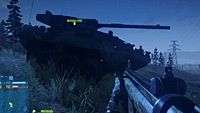 |
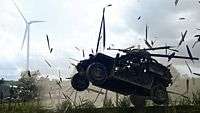 |
 |
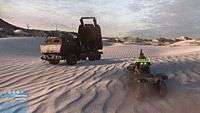 |
 |
The new game mode gracing this expansion is Tank Superiority, which does pretty much exactly what it says on the tin. There is a single flag to capture on any of the four new maps, and it’s always in the same spot: dead-centre and totally open with no cover around it. With only one point to capture that flag becomes the most valuable resource on the map, and with only Tanks and Tank Destroyers to hand, the objective becomes capturing and holding that one point. It’s not as easy as it sounds; the initial vehicle rush essentially lays waste to one side, who then spend a good portion of the next five minutes battering the crap out of the injured and damaged opposition who are dug in and holding the flag. Good use of engineers and snipers is a must; the latter might seem like a ridiculous option on a map full of metal plating for heads to hide behind, but their laser designator and a well placed Javelin team will cripple the strongest of defences. Despite its attempts, Tank Superiority falls short of being an essential part of the Battlefield experience, partly due to being a little one-dimensional and partly due to another problem I’ll come onto shortly.
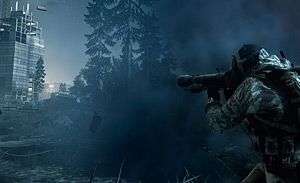 Armored Kill is a good expansion pack, there is no doubt about that, but it is undone by two problems, and they are problems that aren’t directly the fault of EA or DICE, but they’ve caused me issues on several occasions to the point that it has put me off playing the expansion anymore. The first is the size of the map, which sounds like a ridiculous complaint from a Battlefield player, but in this instance size does matter, and here things can be a little too big. The fact is these maps are designed for a high number of players, and the other shitty fact is that a lot of people running a lot of the servers don’t realise this.
Armored Kill is a good expansion pack, there is no doubt about that, but it is undone by two problems, and they are problems that aren’t directly the fault of EA or DICE, but they’ve caused me issues on several occasions to the point that it has put me off playing the expansion anymore. The first is the size of the map, which sounds like a ridiculous complaint from a Battlefield player, but in this instance size does matter, and here things can be a little too big. The fact is these maps are designed for a high number of players, and the other shitty fact is that a lot of people running a lot of the servers don’t realise this.
They seem quite intent on forcing you to play with 32 players, and believe me sixteen-a-side is no fun in this. It simply isn’t enough people to have an enjoyable match. If we do a quick count up: assume one is AFK (someone is always AFK), two people – usually friends with the combined IQ of a lobotomised field mouse – will be fucking around in the spawn point, two others will be strapping C4 to whatever vehicle they can get their hands on and driving off to try and blow up an enemy vehicle on a map so big you can see anything coming a mile off, and another three will just standing at the first flag we’ve captured ‘defending the point’. That’s eight people – half the team, in case the lobotomised rodent men are reading – leaving the other eight to find another eight guys on the opposition side on maps that can be up to five square kilometers in size. These maps demand at least 48 players, ideally the full 64 compliment should be used in order to actually fill out the map. On the slightly smaller ones, ironically the two poorest maps of the pack, this isn’t so much of an issue. On Bandar Desert and Alboraz Mountains, anything less than 48 players is just fucking painful and it doesn’t matter if they lower the amount of flag points or even the ticket count, because it’s just fucking boring.
This leads me onto my second point, and it sounds elitist, but it really isn’t meant to be. This point is just a statement of two unarguable facts, which combined cause me no end of grief. The first is that Battlefield 3 is a team game, first and foremost. Even the best solo shooters have to rely on other people to heal them, resupply them, cover them, and generally aid them. A good solo player can influence a match, but equally you can watch a good solo player fall short of glory in a team full of idiots. The second fact is the aforementioned team of idiots, who are more than capable of ruining any squad they get involved with. On the smaller maps, better solo players can turn the tide, can make an impact, but on maps this size it just isn’t possible.
 As I’ve already said, this isn’t a knock against EA or DICE, it isn’t a fault of the game, but when you are playing on maps this size, its just impossible to do it alone, and not having a good team, especially when the opposition does, makes this less of a joy to play.
As I’ve already said, this isn’t a knock against EA or DICE, it isn’t a fault of the game, but when you are playing on maps this size, its just impossible to do it alone, and not having a good team, especially when the opposition does, makes this less of a joy to play.
Due to the number of new vehicles, there aren’t any new weapons to hand, but some different camos are on offer for existing weapons. These assignments do add a certain amount of life to the expansions, and while there are unlocks for most of the new vehicles, the weapon ones are best unlocked on other maps, because unless you’re actually on a capture point or playing a deathmatch game type, you won’t be doing much shooting with your gun.
Unfortunately, there isn’t too much else to Armored Kill as a package. It sounds like a lot on offer, but the lacklustre nature of a couple of the maps, Tank Superiority missing the mark and no new weapons, means that its only really good with friends or when you’re on the winning side. The new vehicles do add something though, and I can’t take too much shine off the amazing apple that is the AC-130, but as the Aftermath expansion approached I was left feeling a little disappointed by Armored Kill and was concerned that Aftermath wasn’t looking look like it would offer me anything I’d not done before.
Aftermath
 Thankfully, I was wrong. While Armored Kill had offered me enough to keep me occupied, it had left me wanting, which was strange considering it was aiming for an essential Battlefield experience. Aftermath wasn’t filling me with confidence either, the XBOW looking like it would be too slow paced and the maps looked uninspiring. I was worried that the Premium content was starting to peter out towards the end.
Thankfully, I was wrong. While Armored Kill had offered me enough to keep me occupied, it had left me wanting, which was strange considering it was aiming for an essential Battlefield experience. Aftermath wasn’t filling me with confidence either, the XBOW looking like it would be too slow paced and the maps looked uninspiring. I was worried that the Premium content was starting to peter out towards the end.
So what of those ‘uninspiring’ maps then? Well thankfully, they are all awesome. I honestly can’t remember why I was so worried about them, because while each of them looks similar; a war ravaged city, struck by an earthquake that makes a feature in the single-player campaign, each has its own personality and excellent design. These are some of the best maps since Battlefield 2 and in my opinion eclipse some of the standard maps that shipped with Battlefield 3.
The first – and my favourite – is Azadi Palace, a blend of different areas with a large destroyed royal palace of sorts just off-center. Its design is excellent, one half of the map a collection of tightly controlled buildings and a network of alleyways and the other half more spaced apart, a collection of the palace and a small construction site. The only other point is on a small hillside mound that sits between the two sets of points, slightly favouring the Russian side. You’d think that would mean the focus of the fighting would be at the hill point, but by and large that is the quietest point on the map. Instead, both armies tend to blindly invade the other’s territories, creating some amazing battles. The palace is a frequent hotspot, where I’ve seen dozens of men fighting over a single flag. It’s fast, tense madness and manages to top the adrenaline pumping-vehicular chaos of Armored Kill.
 |
 |
 |
 |
 |
 |
The second map on offer is Epicenter, a map that looks even more ruined than the last. This map is one of the most unusual due to the standard flag layout, which sees a staggered formation, not unlike Death Valley on Armored Kill. The only difference is that because the map is smaller in size it doesn’t have a negative effect, and there are a ridiculous amount of ways in and out of flag points. All of them have at least three ways in and out, while some of them boast six, making defence a royal pain in the arse and therefore forcing a constant attacking mindset upon both teams, leading to regular changes in power in small spaces of time.
 The third map is the only one to feature air vehicles, a welcome change of pace due to the lack of said vehicles in the other three. Markaz Monolith is an excellent addition to the swelling map options, boasting a large structure near the centre (some might call it a Monolith?) that acts as a vantage point for snipers and a challenge for any budding helicopter pilots, should they wish to take evasive action to avoid enemy fire due to its hollow centre. The earthquake theme is less prominent away from that central tower, but this is one of the most enjoyable Conquest maps to date and its flag placement ensures that smart tactics are required to pin either team in.
The third map is the only one to feature air vehicles, a welcome change of pace due to the lack of said vehicles in the other three. Markaz Monolith is an excellent addition to the swelling map options, boasting a large structure near the centre (some might call it a Monolith?) that acts as a vantage point for snipers and a challenge for any budding helicopter pilots, should they wish to take evasive action to avoid enemy fire due to its hollow centre. The earthquake theme is less prominent away from that central tower, but this is one of the most enjoyable Conquest maps to date and its flag placement ensures that smart tactics are required to pin either team in.
The final map, Talah Market, is probably the weakest of the bunch, but still strong in its own right. It feels the most ‘run and gun’ of all of the maps, and gives a sense of being a bigger version of a Close Quarters map. There are some vehicles on offer, but these can only really patrol the outer flags and are largely redundant when you get to the market area in the center. Defence is nigh-on impossible due to the multiple entrances and exits and a series of interlinked rooftops and man-made gangways, meaning that always being on the move is the safest way to play.
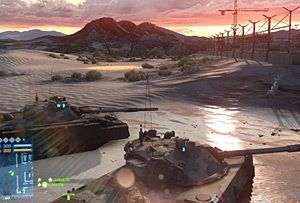 These maps showcase some of the best that DICE has to offer. Multiplayer games such as Planetside 2 and Battlefield 3 show off their best moments not with flashy graphics or big guns, but when those moments, such as the last ditch defence or the gutsy attack, happen organically rather than being a by-product of a feature or a gimmick. Aftermath, unlike Armored Kill, has this in spades and each map continues to feel fresh despite sinking at least thirty hours into just this expansion alone. This expansion has been one of the reasons that games like Far Cry 3, and X:COM continue to collect dust on my desk, despite both being excellent titles in their own right.
These maps showcase some of the best that DICE has to offer. Multiplayer games such as Planetside 2 and Battlefield 3 show off their best moments not with flashy graphics or big guns, but when those moments, such as the last ditch defence or the gutsy attack, happen organically rather than being a by-product of a feature or a gimmick. Aftermath, unlike Armored Kill, has this in spades and each map continues to feel fresh despite sinking at least thirty hours into just this expansion alone. This expansion has been one of the reasons that games like Far Cry 3, and X:COM continue to collect dust on my desk, despite both being excellent titles in their own right.
Aftermath also adds a new weapon to your arsenal in the form of a Crossbow pieced together with parts from other weapons. It’s an interesting choice for a new weapon given the general pace of this expansion. While you’d assume it was a sniper’s choice of weapon it is better as a backup choice for someone walking around with an submachine gun who wants to add some range to their attack. A sniper won’t find much use for this due to the long reload time, meaning that if the first shot misses, the target has moved on. Not such a problem for a soldier on the ground, because you’ll be on the move anyway. The Crossbow – dubbed the XBOW in-game – features heavily in the new assignments that are provided with the expansion, and allow you to work towards unlocking various ammo types.
The various ammunition types are a good attempt at giving the XBOW some more legs, because it would quickly get lost in favour of the more standard weaponry. The standard bolt will kill anyone at short range and is a fatal headshot, although hitting someone with this thing is difficult no matter what bolt you’ve got attached. All the other bolts are assignment unlocks, and consist of a High-Explosive Bolt, Scan Bolt, and Balanced Bolt. The High-Explosive bolt dips like a fat guy falling off a swing, and you’ll need to arc it pretty high to hit anything at range. It can disable transport vehicles and choppers with one hit but has the smallest explosive damage potential of any weapon. Using this to take out a Tank or LAV is a quick way to an early grave, and I’ve only managed it once. The Scan Bolt – as you may imagine – provides a temporary scan of an area; its potential is somewhat lost because it does very little damage as a weapon and you’re effectively defenceless while you’re buggering about with it. The final option, the Balanced Bolt, offers the best range of all the bolts, but at a reduction in damage due to its ‘thin’ design. So how can I summarize the new addition to your weapon loadout? Stick with a gun: It fires bullets.
 While I can’t recommend the XBOW, I can recommend the three new vehicles on offer in this Mad Max style environment, all of which are bloody good fun to use. The Barsuk and Phoneix offer new methods of offensive troop transport for the Russians and Americans respectively. They are both retrofitted from early vehicles – the Vodnik and HUMVEE for each side – and both feature a roof-mounted Grenade Launcher and Heavy Machine Gun. Both require the gunners to be visible to the outside world, meaning increased vulnerability but, equally, more firepower. The final vehicle is the Rhino, offering up extra spaces to drive people round in and a driver-controlled Light Machine Gun. While this beast has all the power and speed of disembowelled badger, it has a surprising amount of armor. For something that looks like a broken Ford Galaxy it is surprisingly resistant to explosives.
While I can’t recommend the XBOW, I can recommend the three new vehicles on offer in this Mad Max style environment, all of which are bloody good fun to use. The Barsuk and Phoneix offer new methods of offensive troop transport for the Russians and Americans respectively. They are both retrofitted from early vehicles – the Vodnik and HUMVEE for each side – and both feature a roof-mounted Grenade Launcher and Heavy Machine Gun. Both require the gunners to be visible to the outside world, meaning increased vulnerability but, equally, more firepower. The final vehicle is the Rhino, offering up extra spaces to drive people round in and a driver-controlled Light Machine Gun. While this beast has all the power and speed of disembowelled badger, it has a surprising amount of armor. For something that looks like a broken Ford Galaxy it is surprisingly resistant to explosives.
The final new and important feature of this expansion is the new game type; Scavenger mode. Essentially reverting to team deathmatch from the 1990s, players are armed only with a pistol and must collect weapons – all of which have limited ammo – that are laying around the maps. Class skills are removed so this essentially becomes a case of which side has the better shooters and weapons – this is fun in short bursts, but I feel a trick has been missed here. The game type is always Conquest Domination – so, small confined maps – and quickly changing flag points. Where is the option to play larger Conquest and Rush? I think having a weapon restriction could potentially make this more challenging, especially with the low ammo count. Do I stay and defend this point with one clip of Aug A3 rounds or make a dash for that Light Machine Gun? You could potentially have backpacks or crates with the odd class specialisation inside. A one-time use defibrillator, or one minute of TUGS use? DICE have done so well with the post-earthquake setting, so why not take it a step further?
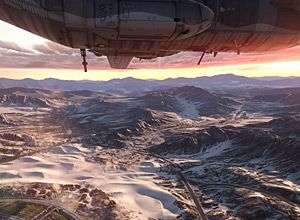 So what of the Premium exclusive content in the last few months? Well, you have the usual double XP events, the exclusive hints, videos and priority queue placement. You also get a fair few new assignments that give you options for unlocking new cameo colours for your weapons. This doesn’t matter to most – myself included – although I prefer the challenge of actually doing the assignment rather than the reward it provides, because some of them are quite tough, especially if it involves playing outside your comfort zone. However, I can’t fault the extras you get with the Premium service. It wouldn’t interest some of the most dedicated gamers, but if you’re a lover of Battlefield 3 then it’s perfect for you.
So what of the Premium exclusive content in the last few months? Well, you have the usual double XP events, the exclusive hints, videos and priority queue placement. You also get a fair few new assignments that give you options for unlocking new cameo colours for your weapons. This doesn’t matter to most – myself included – although I prefer the challenge of actually doing the assignment rather than the reward it provides, because some of them are quite tough, especially if it involves playing outside your comfort zone. However, I can’t fault the extras you get with the Premium service. It wouldn’t interest some of the most dedicated gamers, but if you’re a lover of Battlefield 3 then it’s perfect for you.
The expansion packs themselves carry the quality that I’ve come to expect from the first two. DICE should certainly be proud of what they’ve created with Battlefield 3 and with each of its expansions. Back to Karkand provides the nostalgia, Close Quarters offers respite for any Call of Duty fans who’ve ventured into the great unknown. Armored Kill, despite some flaws, offers a quintessential Battlefield experience, provided you’ve got a group of friends and a large amount of people to play it with. Finally, Aftermath offers something different entirely, a show of strength and flexibility to play with the formula, now that they know the product has sold well. For me, its my favourite since Karkand and with that in mind, I’m eagerly anticipating the final installment when End Game arrives.
Last five articles by Chris














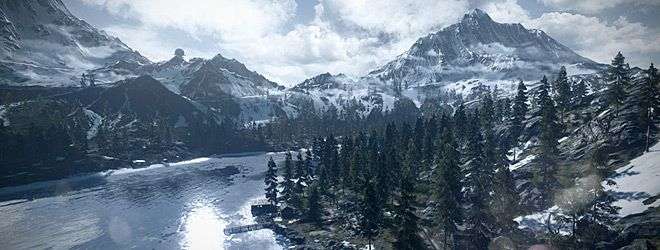








There are no comments, yet.
Why don’t you be the first? Come on, you know you want to!